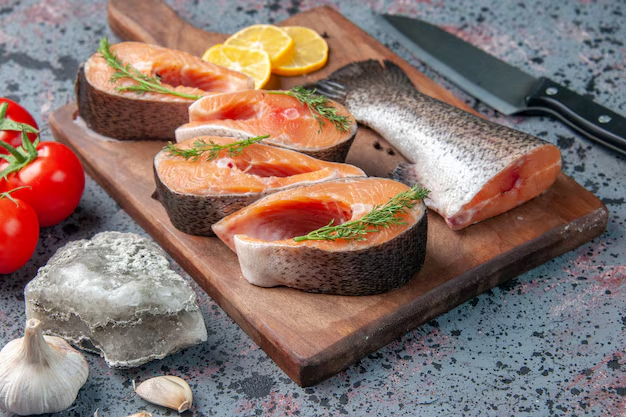Storing Salmon Safely: How Long Can You Keep It in the Fridge?
If you've ever found yourself contemplating how long that mouthwatering salmon fillet can last in your refrigerator before it becomes unsuitable for consumption, you’re not alone. Salmon, a popular and nutritious source of omega-3 fatty acids and protein, is tasty but perishable, and knowing how to store it properly is key to enjoying it safely. This article will dive deep into all you need to know about the optimal storage practices for salmon, offering tips and related insights that can enhance your experience in the kitchen.
🐟 How Long Can You Keep Salmon in Your Refrigerator?
Fresh Salmon
When it comes to fresh salmon, it's best to consume it within 1 to 2 days of purchase. This ensures that the fish retains its prime taste and texture while minimizing the risk of spoilage. Proper storage in the coldest part of your refrigerator at a temperature of 32°F (0°C) helps prolong freshness. You can even consider using an ice-filled container for added coldness.
Cooked Salmon
For cooked salmon, the safe window extends to about 3 to 4 days. This time frame allows you to enjoy leftover meals from a weekend family gathering or a delightful dinner date. Always ensure that cooked salmon is stored in an airtight container to keep it fresh and protect it from absorbing other odors in the refrigerator.
Smoked Salmon
Smoked salmon has a slightly longer shelf life due to the smoking process, which acts as a preservative. Unopened packages can last from 2 weeks to a month in the refrigerator, while opened packages should be consumed within 4 to 5 days. Always refer to the package instructions as they may specify different storage durations based on the brand and smoking process used.
Signs of Spoiled Salmon
Identifying spoiled salmon is crucial in avoiding foodborne illnesses. Here are some signs to look out for:
- Offputting Odor: Fresh salmon should have a subtle scent, reminiscent of the ocean; a strong, fishy smell is a red flag.
- Color Changes: Fresh salmon is vibrant pink or orange, depending on the variety. Any dullness or graying can indicate spoilage.
- Slimy Texture: A slimy or sticky feel is a tell-tale sign that it's time to discard the fish.
- Dull Eyes: If the salmon is whole, check the eyes; they should be clear and bright, not sunken or opaque.
🧊 Storing Salmon in the Freezer
Freezing is an excellent method to extend the shelf life of salmon. Here are some tips:
- Freezing Fresh Salmon: It can last up to 2 to 3 months at peak quality. Use vacuum-sealed bags or heavy-duty aluminum foil for best results.
- Freezing Cooked Salmon: Properly packaged, cooked salmon can maintain quality for 3 to 4 months.
- Freezing Smoked Salmon: This can safely last up to 3 months in the freezer while maintaining its rich flavor.
Tips for Freezing Salmon
- Portion the Fish: Cut your salmon into portion sizes before freezing to make it easier when you thaw it.
- Remove Excess Air: Use airtight containers or vacuum-sealed bags to prevent freezer burn.
- Label and Date: Mark each package with the freeze date for easy tracking.
Thawing Salmon Safely
To thaw salmon safely, move it from the freezer to the refrigerator and let it defrost slowly, which can take several hours or overnight. If you're pressed for time, you can also thaw it by placing the sealed package in cold water, which is faster but requires careful attention.
Quick Thawing Tips
- Cold Water Bath: Submerge the sealed salmon in a bowl of cold water, changing the water every 30 minutes.
- Avoid Room Temperature Thawing: Thawing at room temperature is not recommended due to the risk of bacterial growth.
👩🍳 Making the Most Out of Your Salmon
Delicious Recipes to Try
Incorporating salmon into your meals is a delightful way to enjoy its health benefits. Here are a few simple recipes:
- Baked Salmon with Herbs: Season salmon fillets with lemon, garlic, and fresh dill. Bake at 400°F (200°C) for 12-15 minutes.
- Salmon Salad: Combine cooked, flaked salmon with mixed greens, cherry tomatoes, cucumbers, and a light vinaigrette.
- Smoked Salmon Sandwiches: Layer smoked salmon, cream cheese, capers, and arugula on a toasted bagel.
Enhancing Flavor with Seasoning
Seasoning salmon is all about balancing flavors. Use these tips to enhance its natural taste:
- Herbs and Spices: Dill, thyme, and rosemary pair beautifully with its flavor.
- Citrus Zing: Lemon and lime can add a fresh twist that complements the richness of salmon.
- Sweet and Savory: Honey or maple syrup can create a delightful glaze when combined with soy sauce or mustard.
🌡️ Essential Storage Tips
A summary of key storage practices:
- Fresh Salmon: Fridge for 1-2 days; freeze for long-term.
- Cooked Salmon: Fridge for 3-4 days; freeze leftovers.
- Smoked Salmon: Follow package guidance; usually longer storage.
- Check for Spoilage: Odor, color, texture, and eyes as indicators.
By understanding how to store, thaw, and creatively prepare salmon, you can safeguard this delicious protein's flavor and safety, ensuring that every bite is as delightful as the first. Whether you enjoy it fresh, smoked, or as leftovers, remember that proper handling is key to savoring its wholesome goodness. Happy cooking and eating!
